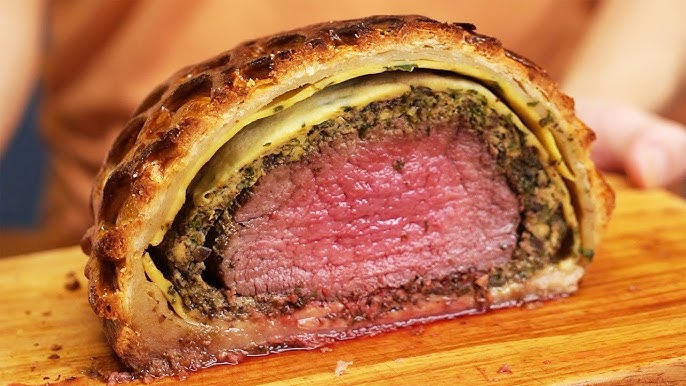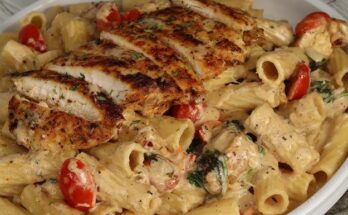Gordon Ramsay Beef Wellington Recipe: Few dishes scream luxury and celebration like a perfectly executed Beef Wellington. Made famous worldwide by the fiery and precise Gordon Ramsay, this classic British dish is a showstopper fit for any special occasion. Rich, savory, and wrapped in a golden puff pastry, it’s no surprise that Beef Wellington is Ramsay’s go-to for impressing guests. Whether you’re preparing it for a holiday, a romantic dinner, or just to sharpen your culinary skills, this step-by-step guide breaks down the mystery behind the dish and helps you master it like a pro.
What is Beef Wellington?
Beef Wellington is a classic British recipe that features a center-cut beef tenderloin coated in mushroom duxelles (a finely chopped mushroom mixture), often combined with pâté or foie gras, then wrapped in parma ham and puff pastry, and baked to golden perfection. The result? A glorious combination of tender, juicy beef surrounded by rich mushroom flavors and crisp, flaky pastry.
Though it’s rooted in British cuisine, the name “Wellington” is thought to have come from Arthur Wellesley, the 1st Duke of Wellington, who reportedly loved meat pies. Over the years, the dish has evolved, and thanks to celebrity chefs like Gordon Ramsay, it’s gained worldwide fame as a gourmet staple.
Making Beef Wellington may seem intimidating at first—it’s one of those dishes where every step matters—but with a bit of patience and the right technique, you’ll create a meal that’s worth every second of the effort.
Why Gordon Ramsay’s Version is Famous
Gordon Ramsay didn’t just put Beef Wellington on the map—he set the gold standard for it. His version emphasizes precision, flavor layering, and impeccable presentation. Ramsay’s Wellington uses high-quality beef, a fragrant mushroom duxelles, and a thin layer of prosciutto for added depth and structure, all sealed within a buttery puff pastry.
What makes Ramsay’s Wellington so memorable is his attention to detail. From the way he sears the beef to lock in juices, to his signature lattice pastry design, Ramsay turns this dish into edible art. When done right, the meat is perfectly medium rare, the mushrooms are deeply savory, and the crust is crisp yet delicate. His method ensures every bite delivers that wow factor.
Ingredients You’ll Need
Core Ingredients for Beef Wellington
To recreate Gordon Ramsay’s signature Beef Wellington, you’ll need the following essentials. Don’t skimp on quality—this dish is all about letting premium ingredients shine.
- Beef Tenderloin (Center Cut) – 2 to 2.5 lbs
- Salt and Black Pepper – for seasoning
- Olive Oil – for searing
- English Mustard – adds a tangy layer after searing
- Chestnut Mushrooms – for the duxelles
- Shallots and Garlic – finely minced for flavor
- Thyme – fresh is best
- Prosciutto (Parma Ham) – for wrapping the beef and duxelles
- Puff Pastry Sheets – preferably all-butter pastry
- Egg Yolk – for the egg wash
- Flour (for dusting) – to prevent sticking
Having these ingredients prepped and ready makes the whole process smoother. Mise en place (everything in its place) is critical in a dish like this where timing and temperature matter.
Optional Ingredients for Enhanced Flavor
Though Gordon Ramsay’s core recipe is straightforward, you can add a few extra touches for depth or personalization:
- Pâté or Foie Gras – traditional and adds richness
- Truffle Oil – mix into the duxelles for luxury
- Spinach or Crepes – helps absorb moisture and prevent a soggy crust
- Dijon Mustard – alternative to English mustard for a subtler tang
Remember, while extra ingredients can elevate your Wellington, overcomplicating things can detract from the classic flavor. Stick to Ramsay’s basics if you’re aiming for authenticity.
Preparing the Beef Tenderloin
Choosing the Right Cut
The star of the show here is the beef, and not just any beef—it has to be tenderloin. Look for a center-cut portion, often called “Châteaubriand,” which is the thickest, most tender part of the fillet. This cut ensures that the meat cooks evenly and stays juicy without overcooking.
When selecting your beef:
- Opt for a piece that’s even in width from end to end.
- Trim any silver skin or excess fat for better searing.
- Choose grass-fed or organic beef for a deeper, richer flavor.
You want the meat to stand out, so this isn’t the place to skimp.
Seasoning and Searing the Beef
Start by seasoning the tenderloin generously with salt and freshly cracked black pepper. This isn’t just about flavor—it also helps form a nice crust when seared.
Steps for perfect searing:
- Heat a couple of tablespoons of olive oil in a heavy pan (cast iron is ideal) until it’s screaming hot.
- Add the beef and sear each side—including the ends—for about 1-2 minutes, until browned and caramelized.
- Remove from heat and immediately brush the beef with English mustard. This adds a zingy contrast and helps tenderize the meat.
- Let the meat cool completely before wrapping. You can refrigerate it to speed up the process.
The goal here is simple: lock in the flavor, seal the juices, and give the pastry a dry, firm surface to cling to. Don’t rush this step—it’s the foundation of your Wellington.
Creating the Duxelles
What is Duxelles?
Duxelles (pronounced “duke-sell”) is a savory mushroom mixture that adds moisture and umami richness to the Beef Wellington. It’s made by finely chopping mushrooms and cooking them down with aromatics until they become a thick, dry paste.
In Ramsay’s version, the duxelles replaces the traditional pâté, making the dish lighter while still packed with flavor. The mushrooms provide earthiness that pairs beautifully with the rich beef and buttery pastry.
Step-by-Step Process to Make Duxelles
- Chop the Mushrooms: Use a food processor to finely mince about 500g of chestnut mushrooms. You want a coarse paste, not a puree.
- Sauté Aromatics: In a hot, dry pan, add a touch of olive oil, then toss in minced shallots, garlic, and thyme. Cook until softened and fragrant.
- Add Mushrooms: Add the minced mushrooms to the pan and cook over medium heat. Stir frequently.
- Evaporate Moisture: Continue cooking for 10–15 minutes until all moisture has evaporated and the mixture is thick and paste-like.
- Cool Completely: Transfer the duxelles to a bowl and let it cool. You can also chill it in the fridge for faster handling.
The key is to ensure the mixture is dry. Excess moisture will turn your pastry soggy—every Wellington-maker’s worst nightmare. Ramsay is strict about this step, and for good reason. A dry, flavorful duxelles makes all the difference.
Assembling the Beef Wellington
Wrapping with Prosciutto and Puff Pastry
Now that your beef is seared and your duxelles is ready, it’s time to assemble the masterpiece. This is the part where the real magic happens—and where things can go wrong if you don’t follow the process carefully. Gordon Ramsay is meticulous about keeping the layers balanced and tight so the Wellington cooks evenly and beautifully.
Step-by-step wrapping instructions:
- Prepare the prosciutto layer: Lay out a large sheet of plastic wrap on your work surface. Place the prosciutto slices overlapping each other in a rectangle large enough to wrap the beef. Think of it as a blanket for your tenderloin. This layer helps trap moisture and keeps the pastry from getting soggy.
- Spread the duxelles: Using a spoon or spatula, evenly spread the cooled mushroom duxelles over the prosciutto layer. Don’t overdo it—you want a thin, even coating.
- Place the beef: Put your chilled, mustard-coated beef tenderloin right in the center. Carefully use the plastic wrap to roll everything around the beef, forming a tight, even log. Twist the ends of the plastic wrap to seal it tight.
- Chill again: Place the wrapped log in the fridge for 15–20 minutes. This helps it firm up and hold its shape for the next layer—the puff pastry.
The goal here is precision and symmetry. Each layer needs to be tight, uniform, and dry. Ramsay often says that if you mess up the wrapping, the whole Wellington suffers. So take your time and do it right!
Chilling for the Perfect Shape
Before wrapping with puff pastry, it’s crucial to chill the beef-prosciutto bundle. Chilling serves multiple purposes:
- It firms up the log, making it easier to wrap.
- It keeps the pastry from melting prematurely.
- It helps ensure the final Wellington holds its shape while baking.
Once the wrapped beef is cold and firm, it’s time to apply the final and most delicate layer—puff pastry.
Final wrapping tips:
- Roll out the pastry: Lightly flour your work surface and roll out your puff pastry into a large rectangle, enough to fully encase the beef. All-butter pastry is best for flavor and texture.
- Wrap it up: Remove the plastic wrap and place your beef log in the center of the pastry. Brush the edges of the pastry with beaten egg yolk to help seal.
- Seal and trim: Fold the pastry over the beef, trimming any excess and pressing the edges to seal completely. Make sure the seam is on the bottom.
- Decorate (optional): If you want to be extra fancy like Gordon, use pastry trimmings to add a lattice or decorative shapes on top.
- Chill again (yes, again): Return the Wellington to the fridge for 15–20 minutes to firm up before baking.
You’re now ready to move on to baking—but don’t skip the chilling steps. They’re essential for creating that iconic Wellington look: clean lines, golden crust, and evenly cooked beef.
Baking the Beef Wellington
Perfecting the Oven Temperature and Timing
You’ve made it this far—don’t mess it up now! Baking the Beef Wellington correctly is crucial. Overbake it, and you’ve ruined that beautiful tenderloin. Undercook it, and the pastry will be doughy. Timing and temperature are everything here.
Oven settings:
- Preheat your oven to 400°F (200°C)
- Use a fan-assisted (convection) setting if available for even heat distribution
Baking instructions:
- Egg wash the pastry: Brush the chilled Wellington all over with beaten egg yolk. This gives the pastry its shiny, golden finish.
- Score the top (optional): Lightly score the surface with a knife in a criss-cross or diagonal pattern. Don’t cut too deep—just enough for aesthetics.
- Bake on a tray: Place the Wellington on a parchment-lined baking tray. Bake in the preheated oven for about 35–40 minutes for medium-rare.
- Check with a meat thermometer: Internal temperature should read 125°F (52°C) for medium-rare. Adjust the baking time accordingly if you want it more or less done.
- Rest before slicing: Once out of the oven, let it rest for 10–15 minutes. This allows the juices to redistribute and prevents a soggy crust.
A good meat thermometer is your best friend here. It ensures the beef is just right and saves you from slicing into a disaster. Gordon Ramsay often emphasizes that the Wellington’s success lies in the balance—crisp on the outside, pink and juicy on the inside.
Tips for Serving and Presentation
This is your moment of glory. You’ve built layers of flavor, texture, and aroma—now it’s time to plate like a pro.
Plating suggestions:
- Use a sharp serrated knife to slice into thick medallions (1.5 to 2 inches thick).
- Serve with a rich red wine jus, port reduction, or classic beef gravy.
- Accompany with simple sides like roasted potatoes, baby carrots, or sautéed green beans.
- Garnish with microgreens or a sprinkle of sea salt for a chef’s touch.
Wellington is rich, so keep the sides light and fresh. It’s meant to be indulgent but not overwhelming. Gordon’s favorite pairings often include a full-bodied red wine and a light salad to cleanse the palate.
Common Mistakes to Avoid
Overcooking the Beef
Overcooking the tenderloin is perhaps the most heartbreaking mistake you can make with Beef Wellington. The beauty of this dish lies in its medium-rare, juicy center. Anything more, and the beef becomes dry and chewy—not exactly the fine dining experience we’re aiming for.
How to avoid it:
- Use a meat thermometer. It’s not optional—it’s essential. Insert it into the center of the beef. For medium-rare, remove the Wellington when the internal temperature reaches 125°F (52°C).
- Understand carryover cooking. Even after you take it out of the oven, the beef continues to cook for several minutes due to residual heat. If you wait until it hits 135°F in the oven, you’ll end up with medium or worse.
- Avoid opening the oven too often. Let the heat stay consistent and monitor progress using the oven light and thermometer.
Gordon Ramsay emphasizes being “fearless but focused.” You need to trust your process and timing. Use your tools, know your oven, and don’t let impatience sabotage your dish.
Soggy Pastry Base
Nothing ruins the experience of a Beef Wellington faster than a soggy bottom crust. After all that effort—searing, layering, chilling—it’s devastating to cut into a beautifully golden Wellington and find a mushy mess at the bottom.
Prevent this kitchen tragedy with these pro tips:
- Dry everything thoroughly. Make sure the duxelles is completely moisture-free before assembly. Same with the prosciutto layer.
- Use a crepe or spinach layer. Ramsay sometimes adds a thin layer of cooked crepe between the prosciutto and pastry to act as a moisture barrier.
- Chill before baking. The final chill helps set the Wellington and reduces the chance of the butter in the puff pastry melting too early.
- Use a baking rack or perforated baking tray. This allows air to circulate and prevents steaming from underneath the Wellington.
A crisp, buttery pastry wrapping is half the magic of this dish. Don’t let sogginess ruin it—be meticulous, not rushed.
Customizing the Beef Wellington
Making It Your Own
While purists may say Gordon Ramsay’s recipe is untouchable, the reality is that you can absolutely tweak your Beef Wellington to suit your tastes. The classic components—beef, mushroom, pastry—are a canvas for creativity.
Here are some easy and delicious variations:
- Swap the mushrooms: Not a fan of chestnut mushrooms? Try portobello, porcini, or shiitake for a different depth of flavor.
- Go vegetarian: Replace the beef with a hearty portobello mushroom cap or a large beetroot for a meatless version. Use a spinach and walnut filling for an earthy twist.
- Add cheese: A thin layer of blue cheese or goat cheese between the beef and duxelles can add a creamy tang.
- Change the mustard: Try Dijon, horseradish mustard, or a spicy whole-grain variety.
- Spice it up: Mix a pinch of chili flakes or cayenne pepper into the duxelles for a subtle kick.
Customization allows you to play with the recipe while still respecting the technique. Ramsay’s method gives you the structure—you supply the creativity.
Pairing Ideas for a Complete Meal
Once you’ve created your masterpiece, pair it with complementary dishes and drinks to round out the experience. Since Beef Wellington is rich and layered, you’ll want sides and drinks that balance and highlight those flavors.
Best side dishes:
- Garlic mashed potatoes
- Honey-roasted carrots or parsnips
- Green beans almondine
- Creamed spinach
- Cauliflower purée
Ideal wine pairings:
- Cabernet Sauvignon – full-bodied and bold
- Merlot – soft tannins and dark fruit notes
- Pinot Noir – earthy and smooth, great with mushrooms
- Malbec – spicy and robust, ideal for beef
Non-alcoholic options:
- Pomegranate juice
- Sparkling grape juice
- Unsweetened iced tea with lemon
Planning the full menu in advance ensures your Beef Wellington shines as the centerpiece it was meant to be.
FAQs about Gordon Ramsay Beef Wellington Recipe
1. Can I make Beef Wellington in advance?
Yes! You can assemble the Wellington (up to the puff pastry wrapping) and keep it chilled for up to 24 hours before baking. Just apply the egg wash right before it goes in the oven.
2. What can I use instead of prosciutto?
You can use Parma ham, serrano ham, or even very thin slices of smoked turkey. The key is something thin, salty, and not too moist.
3. How do I reheat leftovers without ruining them?
Reheat slices in a 350°F (175°C) oven for 10–15 minutes. Avoid microwaving—it will make the pastry soggy.
4. Can I freeze Beef Wellington?
Yes, but it’s best to freeze before baking. Wrap tightly in plastic and foil, then bake straight from frozen, adding about 10–15 minutes to the cook time.
5. What’s the best alternative cut of beef?
While tenderloin is ideal, you could try sirloin or even filet mignon medallions for individual servings. Just keep in mind, cooking times will vary.
Conclusion
Beef Wellington isn’t just a dish—it’s an event. It’s a statement of skill, patience, and culinary artistry. Gordon Ramsay’s recipe, with its refined layers and bold flavors, turns a simple piece of beef into an unforgettable dining experience.
Sure, it’s not the easiest thing to make. It demands attention, precision, and time. But the result? Worth every second. From the tender, perfectly cooked beef to the earthy mushroom duxelles and flaky puff pastry, it’s a celebration of textures and taste.
Whether you’re cooking to impress or simply pushing your culinary limits, Beef Wellington is your Everest. And with this step-by-step guide, you’ve got the best map to climb it. Follow Ramsay’s principles—keep it tight, keep it dry, keep it hot—and you’ll be plating up perfection in no time.



